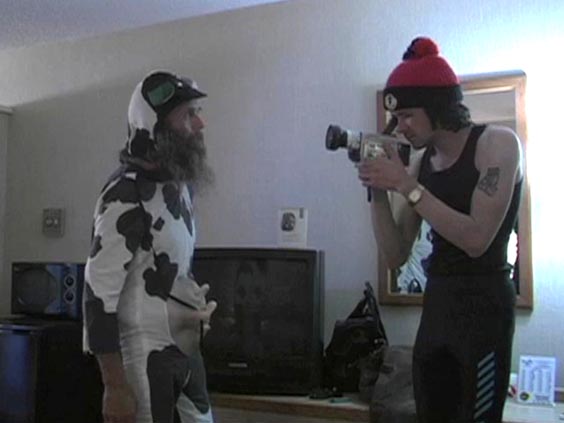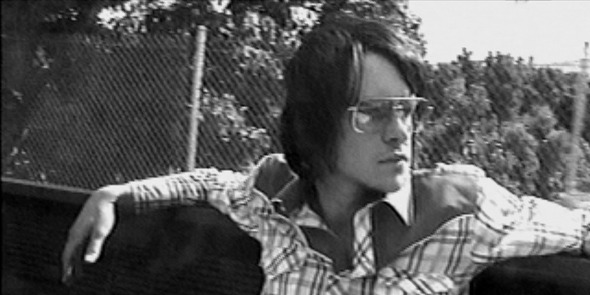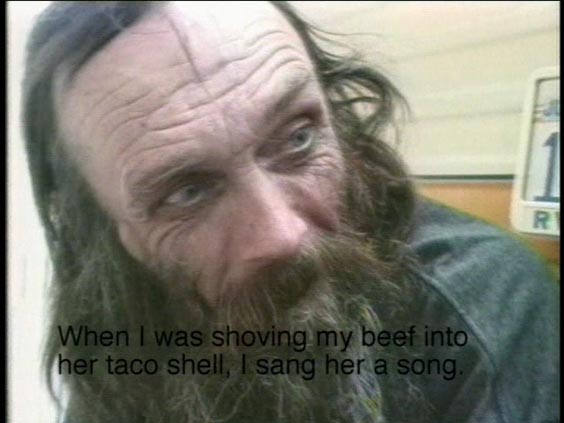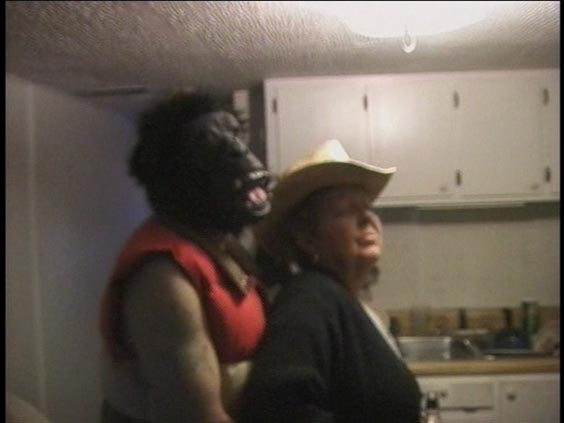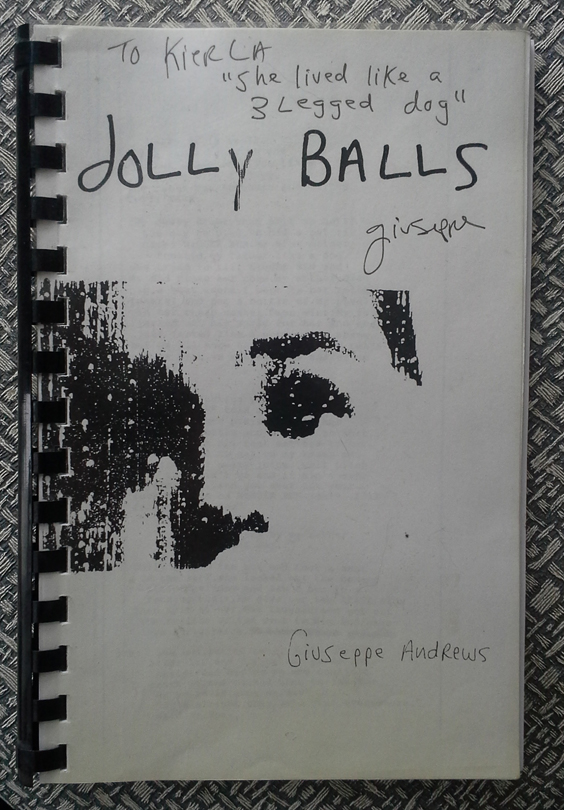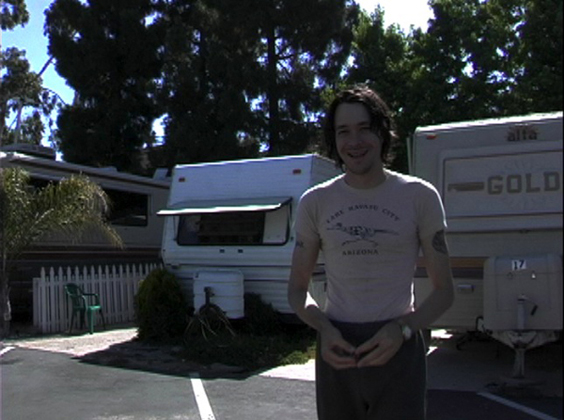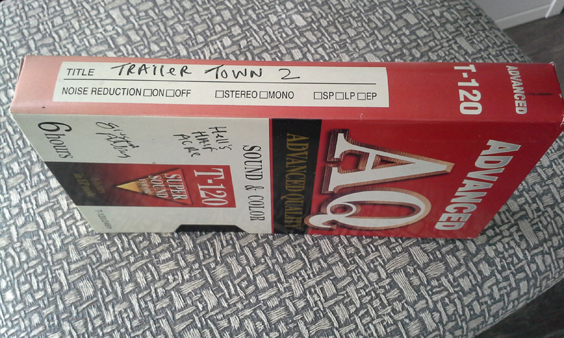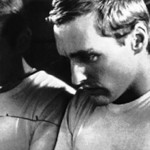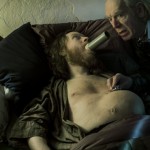FRACTURED FAIRYTALES: ‘GIUSEPPE MAKES A MOVIE’
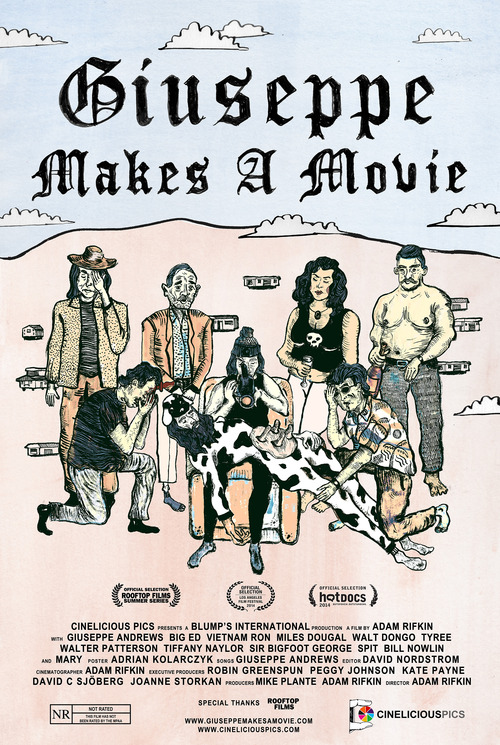 Adam Rifkin’s(THE DARK BACKWARD) documentary about independent filmmaker Giuseppe Andrews was a long time coming; its context is the shoot of Andrews’ 2007 film GARBANZO GAS – about a cow (played by Andrews regular Vietnam Ron) who gets an all-expenses paid vacation to a motel (the same motel used in most of Andrews’ films), not realizing that his vacation will culminate in a trip to the slaughterhouse. Rifkin’s documentary finally made its world premiere at Hot Docs in 2014, transitioning Andrews from an unknown director celebrated by a small cadre of outsider film fans to an inspirational “whirling dervish” (as Rifkin called him in an interview) whose cachet instantly increased among the global arts community. Not that Andrews himself could care less about winning any popularity contest.
Adam Rifkin’s(THE DARK BACKWARD) documentary about independent filmmaker Giuseppe Andrews was a long time coming; its context is the shoot of Andrews’ 2007 film GARBANZO GAS – about a cow (played by Andrews regular Vietnam Ron) who gets an all-expenses paid vacation to a motel (the same motel used in most of Andrews’ films), not realizing that his vacation will culminate in a trip to the slaughterhouse. Rifkin’s documentary finally made its world premiere at Hot Docs in 2014, transitioning Andrews from an unknown director celebrated by a small cadre of outsider film fans to an inspirational “whirling dervish” (as Rifkin called him in an interview) whose cachet instantly increased among the global arts community. Not that Andrews himself could care less about winning any popularity contest.
I first heard of Giuseppe Andrews at the Sitges Film Festival in 2002; Sitges was still a long way off from hearing of him, but one of their guests, a then-young and eager filmmaker named Eli Roth, was presenting his film CABIN FEVER as part of the official selection. Andrews was among the cast of Roth’s 80s frat-horror throwback, playing the stoner Deputy Winston, and had started making a name for himself as an actor in films like NEVER BEEN KISSED (1999), INDEPENDENCE DAY (1996), and – most notably – Adam Rifkin’s DETROIT ROCK CITY (1999). The latter got him into the teen heartthrob annals, and it seemed his career an actor was beginning to flower.
Except, as Roth told us, Andrews had no real interest in being an actor. Unless it was a means of funding his own independent films he was making out of a trailer in Ventura California, where he lived with his father, respected session musician (and lead guitarist for short-lived 60s psych/blues band Magic) Joey Murcia. The same year DETROIT ROCK CITY premiered, Andrews unleashed his own first film as a director: TOUCH ME IN THE MORNING, starring Andrews himself alongside Bill Nowlin, a onetime millionaire who blew his fortune on a drug addiction and came to roost in Andrews’ trailer park.[i] Rifkin himself would come on as producer part way through.
As Roth excitedly flailed and gesticulated, describing Andrews’ films as hundred-dollar lo-fi epics featuring a swath of inebriated senior citizens and meth-heads emitting the most poetically vulgar dialogue imaginable – the magnum opus being something called “TRAILER TOWN”, yet to premiere at the New York Underground Film Festival the following spring – our small circle grew and swelled with interest. Here we were at the world’s most prestigious genre film festival and all we wanted to do was get back home, get a VCR and get our hands on some of these movies.
TRAILER TOWN did not disappoint. Bill Nowlin stars as a foul-mouthed, racist septuagenarian stand-up comedian who lives in a trailer park alongside a gaggle of winos, aging sex-addicts, trailer pirates and his black stepson Stan – who, despite Bill’s racist tirades – is also his best friend. When threatened with eviction, the trailer park oddballs join forces in a standoff against the landlords.
While the film is gleefully full of ‘offensive’ language, it is the climactic soliloquay by Vietnam Ron that really conveys director Andrews’ feelings on his filmmaking context:
“There used to be this Mexican girl that lived around here. And she had unbelievable beauty. And she always looked nice. She had tight, black pants. And her hair flowed through the wind. But she lived in this shitty apartment. It wasn’t much bigger than a toilet bowl. And it looked so strange to see such a sweet, little lovely, coming out of such a scum pit. But I’d sit there and watch her come out of that place every day though. I dreamed about riding up on a white horse and taking her away. But I thought to myself, look at what the world does to beauty. Look at where the world puts beauty. They keep beauty in shitholes!”
But it was WHO FLUNG POO (2004) that really won me over because it was, despite its scatological concerns, a sweet movie, its romance underscored by music from Magic’s 1971 self-titled album, including the film’s beautiful opening track “Don’t use your love to blind me”. Walter Patterson stars as an artist named Poo who makes paintings of chicken pot pies out of homeless people’s feces. Falling on hard times, he and his long-suffering girlfriend (the late, great Gayle Wells) decide to pursue a new career path: pregnant porn. But when that fails to earn them the fortune they anticipate, Poo has to resort to drastic measures to pay the rent.
My first viewing of Andrews’ films as a director coincided with my first year as a programmer for the original single-screen Alamo Drafthouse in Downtown Austin, and we proposed to Roth that he get us in touch with Andrews for a screening with him in person. We’d hosted a lot of guests by that point, but Andrews was one of the most perplexing; alternately hot and cold, excited and withdrawn. Tim League’s cleaning lady walked in on him playing his guitar naked in the guest room and she was apparently quite shocked. I asked him about his writing process. No drinking, he said. No drugs. It made him too foggy the next day and he couldn’t write. He didn’t just write screenplays either – he gave me a copy of his self-published, Xeroxed book DOLLY BALLS, inscribed to me: “She lived like a three-legged dog.”
Rifkin’s documentary gets deep into Andrews’ artistic process, from his formulas for success – including a strict daily diet of sardines – to his work with actors, which includes spoon-feeding them their lines one by one (editing out his own voice later to create a surrealistically choppy chain of events) to his wholehearted encouragement of them as creative beings, no matter what their background. The community he has fostered through his filmmaking may be his greatest achievement of all, and Rifkin’s film beautifully captures these relationships without dwelling on any number of potential hard-luck stories.
Like any behind-the-scenes doc on movie-making, Rifkin’s film is rife with anecdotes: actor Miles Dougal (one of Andrews’ co-stars in Rifkin’s DETROIT ROCK CITY and star of Andrews’ film ACTOR) offering to snort laundry detergent, resulting in a medical scare; Andrews randomly picking up homeless people for a quick day’s work when other cast members bail; Andrews thoughtfully (and repeatedly) cleaning up elderly actor Tyree’s behind after he’s soiled himself; the boost Andrews gives to a down-on-her-luck stripper who confesses that starring in Andrews’ films have changed her life. In fact, all the actors reveal that working with Andrews is a welcome respite to what can sometimes be a difficult existence.
At some point in 2004 or 2005, I pitched Filmmaker Magazine on an interview with Andrews, which became the one and only article I ever wrote for them. While writing it, Andrews told me he’d chucked all his movies in the trash, and they’d been pulled from distribution on his website (since then he’s created a new website at www.giuseppeandrews.net, the biography of which says only “I was born, I lived, I died for art.”). In Rifkin’s film his father says he secretly kept copies of everything Giuseppe threw away, which is a good thing, since after several moves I confess my VHS copies of ACTOR and TRAILER TOWN 3: KISS THE COOK may not have survived. But Andrews’ actions speak to his disinterest in following any conventional filmmaking opportunities that may come his way, or in maintaining any kind of fanbase for his work.
His anti-promotional stance has only intensified since then. The screening of GIUSEPPE MAKES A MOVIE at Montreal’s Festival du Nouveau Cinema in October 2014 (where I saw the film) was followed by a recent short film by Andrews called VAGRANT WOMB (2014). Far more abstract in nature and forgoing the more-or-less narrative structure of his previous features (if equally engaged in spectacle), VAGRANT WOMB was made following Andrews’ move to Austin, TX, where he continues to make films, music and art books with the help of his longtime girlfriend Mary Beth at an inexhaustible rate.
Andrews’ films undoubtedly fall into the realm of avant garde, but his early work was far more openly embraced by the exploitation/cult film crowd. For a while, it was goofy provocateurs Troma Films who were his loudest champions, often employing the gross-out angle to sell the misunderstood auteur’s work. A quote from my Filmmaker article would make its way onto the cover of the Troma DVD for TOUCH ME IN THE MORNING. Troma loved Andrews. One got the sense it was not reciprocal, and their formal relationship was short-lived. As Rifkin’s documentary points out, this is one of the conundrums of 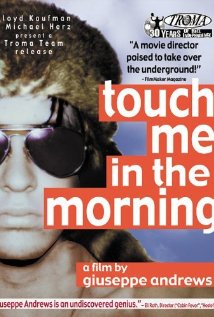 Andrews’ work; influenced by filmmakers like Bunuel, Herzog and Fassbinder in both tone and prolificity, his lack of a working budget and his emphasis on a transgressive microcosmic vernacular means that his films have a surface appeal to audiences that aren’t necessarily interested in his reference points. But even the cult film fanbase generated by Troma’s efforts has waned since Andrews has shifted gears to focus more on music and visual arts.
Andrews’ work; influenced by filmmakers like Bunuel, Herzog and Fassbinder in both tone and prolificity, his lack of a working budget and his emphasis on a transgressive microcosmic vernacular means that his films have a surface appeal to audiences that aren’t necessarily interested in his reference points. But even the cult film fanbase generated by Troma’s efforts has waned since Andrews has shifted gears to focus more on music and visual arts.
My Filmmaker article has long since disappeared, as I feared it would once the editor told me it would be a “web-exclusive” and not in the print magazine. Of course several computer crashes later, I have no copy of it either. With Andrews reluctant to self-promote or do interviews – and especially any that he takes seriously – Rifkin’s candid, personal film becomes an even more essential document of a ballsy, uniquely authentic filmmaker whose world is otherwise characterized by its own transience.
++++
GIUSEPPE MAKES A MOVIE OFFICIAL WEBSITE: http://giuseppemakesamovie.com/
Guiseppe Andrews OFFICIAL WEBSITE: http://www.giuseppeandrews.net/
*Note: The ‘Fractured Fairytales’ reference in the title of this article comes from something Adam Rifkin said in an interview with Filmmaker Magazine upon his documentary’s NY Premiere in 2014.
[i] According to an interview I did with Andrews back in…2004? 2005? The transcript is long-lost. It could be an exaggeration on Andrews’ part, but this is what he told me.

 February 2, 2015
February 2, 2015  No Comments
No Comments
